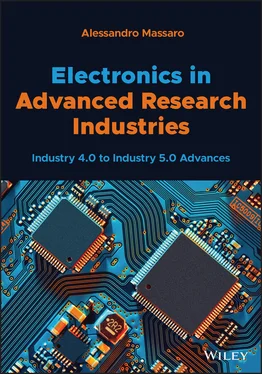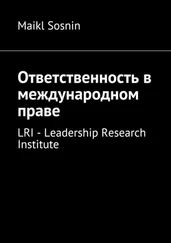1 Cover
2 Title Page
3 Copyright Page
4 Dedication Page
5 Preface
6 About the Author
7 1 State of the Art and Technology Innovation 1.1 State of the Art of Flexible Technologies in Industry 1.2 State of the Art of Scientific Approaches Oriented on Process Control and Automatisms 1.3 Intelligent Automatic Systems in Industries 1.4 Technological Approaches to Transform the Production in Auto‐Adaptive Control and Actuation Systems 1.5 Basic Concepts of Artificial Intelligence 1.6 Knowledge Upgrading in Industries References
8 2 Information Technology Infrastructures Supporting Industry 5.0 Facilities 2.1 Production Process Simulation and Object Design Approaches 2.2 Electronic Logic Design Oriented on Information Infrastructure of Industry 5.0 2.3 Predictive Maintenance: Artificial Intelligence Failure Predictions and Information Infrastructure Layout in the Temperature Monitoring Process 2.4 Defect Estimation and Prediction by Artificial Neural Network 2.5 Defect Clustering and Classification: Combined Use of the K‐Means Algorithm with Infrared Thermography for Predictive Maintenance 2.6 Facilities of a Prototype Network Implementing Advanced Technology: Example of an Advanced Platform Suitable for Industry 5.0 Integrating Predictive Maintenance 2.7 Predictive Maintenance Approaches 2.8 Examples of Advanced Infrastructures Implementing AI 2.9 Examples of Telemedicine Platforms Integrating Advanced Facilities References
9 3 Human–Machine Interfaces 3.1 Mechatronic Machine Interface Architectures Integrating Sensor Systems 3.2 Machine‐to‐Machine Interfaces: New Concepts of Industry 5.0 3.3 Production Line Command and Actuation Interfaces in Upgraded Systems 3.4 McCulloch–Pitts Neurons and Logic Port for Automatic Decision‐Making Setting Thresholds 3.5 Programmable Logic Controller I/O Ports Interfacing with AI Engine 3.6 Human–Machine Interface for Data Transfer and AI Data Processing 3.7 Example of Interface Configuration of Temperature Control 3.8 AI Interfaces Oriented on Cybersecurity Attack Detection 3.9 AI Interfaces Oriented on Database Security 3.10 Cybersecurity Platform and AI Control Interface References
10 4 Internet of Things Solutions in Industry 4.1 Cloud Computing IoT 4.2 IoT and External Artificial Intelligence Engines 4.3 Blockchain and IoT Data Storage Systems 4.4 Mechatronic Machine Interface Architectures Integrating Sensor Systems 4.5 Multiple Mechatronic Boards Managing Different Production Stages References
11 5 Advanced Robotics 5.1 Collaborative Robotics in Industry and Protocols 5.2 Artificial Intelligence in Advanced Robotics and Auto‐Adaptive Movement 5.3 Human–Robot Self‐Learning Collaboration in Industrial Applications and Electronic Aspects 5.4 Robotics in Additive Manufacturing References
12 6 Advanced Optoelectronic and Micro‐/Nanosensors 6.1 Nanotechnology Laboratories in Industries 6.2 Micro‐ and Nanosensors as Preliminary Prototypes for Industry Research 6.3 Multisensor Systems and Big Data Synchronization of Micro‐/Nanoprobes References
13 7 Image Vision Advances 7.1 Defect Classification by Artificial Intelligence and Data Processor Units 7.2 Image Vision Architectures and Electronic Design 7.3 Image Segmentation and Image Clustering 7.4 Image Segmentation for Food Defect Detection 7.5 Random Forest Pixel Classification References
14 8 Electronic and Reverse Engineering 8.1 Reverse Engineering Systems and Mechanical Precision 8.2 Working Processing and Adaptation 8.3 Reverse Engineering and Self‐Learning Automatic Working Piece Classification 8.4 Tools Supporting RE: AR and Image Processing for Size Measurement 8.5 RE in Micrometric Scale: RE Approach for Photonic Crystals 8.6 RE for the Production of Pipeline Components 8.7 RE in the Precision Manufacturing Process for Thin Film Devices 8.8 Advanced RE Processes in Industry 5.0 8.9 RE in Nanocomposite Production Processes 8.10 RE in Electronic Board Production References
15 9 Rapid Prototyping 9.1 Rapid Prototyping Tools and Microscale Electronic Systems: Methodological Approaches 9.2 Examples of Antenna and Detection System Rapid Prototyping 9.3 Principles of Mechanical Piece Rapid Prototyping and Innovative Materials 9.4 Rapid Prototyping and Artificial Intelligence Upgrade 9.5 Rapid Prototyping Oriented Toward Patent Development 9.6 Nanocomposite Artificial Skin Rapid Prototyping Process References
16 10 Scientific Research in Industry 10.1 Guidelines to Construct an Advanced Research Unit in Industry in the Electronic and Mechatronic Field 10.2 Guidelines to Formulate a Patent 10.3 Guideline to Propose Technological Advances for Public Entities and in Industry 5.0 Research Project 10.4 Innovation Process Projects: Example of a Smart Wine Factory 10.5 Guideline for Project Management References
17 Abbreviations and Acronyms
18 Index
19 End User License Agreement
1 Chapter 1 Table 1.1 Spectral ranges of infrared technology. Table 1.2 Advantages and disadvantages of network typologies. Table 1.3 Main specifications of sensors used for traceability. Table 1.4 Main specifications of sensor transmission protocols. Table 1.5 Other protocols usable in industry. Table 1.6 Classification of machine learning algorithms. Table 1.7 Possible limits of advanced technologies and technical risks. Table 1.8 Goals achievable in manufacturing industry. Table 1.9 Example of a correlation matrix for a model with five attributes ( Table 1.10 Industrial sectors and advanced application fields.
2 Chapter 2 Table 2.1 Functions of objects constituting a data processing workflow. Table 2.2 Algorithm performance indicators and related formulas. Table 2.3 Functions of actors of the AR system. Table 2.4 Limits of the AR system. Table 2.5 Technologies and examples of implementable logics. Table 2.6 Example of a 4M map. Table 2.7 Types of control charts.Table 2.8 Main specifications of the AR communication system.Table 2.9 Maintenance definitions.Table 2.10 Predictive actions for a polishing process.Table 2.11 Best measured main parameters for locomotive brake tests.Table 2.12 Example of advanced information platforms integrating artificial ...Table 2.13 Main specification of the telecardiology network.
3 Chapter 3Table 3.1 Risks arising from technological innovation.Table 3.2 Examples of wireless sensor protocols.Table 3.3 Main specifications of communication protocols.Table 3.4 Logic conditions and actuation of the production system illustrate...Table 3.5 Example of a dataset used for the automated classification of the ...Table 3.6 Calculated bias and weight values for each neuron of the hidden la...
4 Chapter 4Table 4.1 Application of basic sensors in industry.Table 4.2 IoT sensors in a secure working environment.Table 4.3 Requirement for intelligent load switching.Table 4.4 Electrical abnormalities.Table 4.5 Example of online configuration for a platform controlling machine...Table 4.6 Example of online configuration for a platform controlling a railw...Table 4.7 Example of online configuration for a platform controlling a road ...Table 4.8 Example of online configuration for a platform controlling a quarr...Table 4.9 Example of online configuration for a telemedicine platform.Table 4.10 Blockchain class definition.
5 Chapter 5Table 5.1 The main classifications for industrial robots.Table 5.2 Robot task classification.Table 5.3 Robot protocols.Table 5.4 AI facilities applied in additive manufacturing.
6 Chapter 6Table 6.1 Main properties of the PDMS polymer.Table 6.2 Main properties of the PDMS‐Au material.Table 6.3 Oil concentrations associated with the oil droplets.
7 Chapter 7Table 7.1 Encoder 8×3 inputs and outputs.Table 7.2 Data processed by the network model in Figure 7.9.Table 7.3 Critical aspects of infrared thermography implementation in indust...
Читать дальше












